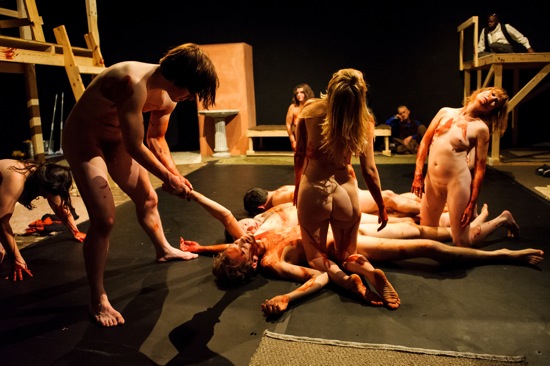
The tragic end of Rude Mech’s reconstruction of the Performance Group’s Dionysus in 69 (after Euripedes). The principal dead body: Pentheus (Josh Meyer) ruler of Thebes. Photo (dress rehearsal): Ian Douglas
“Why a dance critic?” Richard Schechner doesn’t use those words, but he implies them as he greets me at New York Live Arts, where I’ve arrived for a reconstruction by the Austin, Texas, ensemble Rude Mechs of his Dionysus in 69. Why not? For one thing, I missed this epochal and controversial piece of “environmental theater” (Schechner’s term), when he and his actors presented it in the Performing Garage down on Wooster, beginning in the summer of 1968.
For another, dance is the life’s blood—in more ways than the cliché indicates—of Euripides’ The Bacchae, on which Dionysus in 69 is based. Dionysus, spawn of one of Zeus’s copulations with a human female, arrives in Thebes angry. His rites aren’t being observed; his uptight, soldierly boy cousin, Pentheus, who now rules the city, has forbidden them. The god of wine has come in disguise with an entourage of women from Lydia, a more laid-back culture. He aims to encourage the Theban women to leave their looms, crown themselves with ivy (maybe chewing some for its hallucinogenic effect) and roam the hills, dancing wildly in his honor. They also hunt down animals and tear them limb from limb. It’s certainly a good way to get Zeus to notice his bastard and acknowledge paternity.
The dancing is one of the instruments of Euripides’ tragedy. When the seductive blond stranger and his followers break out of Pentheus’s prison (no sweat), he lures the snotty boy king into dressing as a woman in order to spy on the possibly erotic rites. The empowered women— maddened by their dancing and their visions—join Pentheus’s mother, Agave, and her sisters in ripping him apart. Agave is convinced that the head she bears triumphantly home is that of a lion cub. With her final understanding of what she has done, Thebes is undone. Never tangle with a god.
Dionysus in 69 cracks open Euripides’ plot in order to acknowledge ideas, trends, and revolutionary events that marked the 1960s. Schechner and his cast began rehearsing in January, 1968, months after a horde of hippies instituted a “Summer of Love” in San Francisco’s Haight-Ashbury. 1968 was a year of protests—marches, sit-ins, love-ins, and rallies—and not just in the U.S. Here, resistance to the escalating war in Viet Nam burned hotter with the disclosure of the My Lai massacre. Martin Luther King was assassinated in April; on June 5, the night before Dionysus in 69 opened, Robert Kennedy, a presidential candidate for the upcoming election, was fatally shot. Like 2012, 1968 was an election year, the one that inaugurated Richard Nixon’s administration.
Remember the slogan, “Make Love Not War?” It appeared on buttons, t-shirts, posters, handouts. This counterculture mantra is certainly one of the themes of Dionysus in 69; it infuses the central dialogue between Dionysus and Pentheus and amplifies its erotic undertones. But Schechner’s re-tooling of the play for a 1960s audience also suggests that, in the end, unlimited freedom to do whatever you want may lead to problems. And however much the production invites spectators to participate, their involvement can happen only at appointed times. One of Schnecher’s three rules for audiences is that their “participation should not be gratuitous.”
It’s understandable why Rude Mechs— an ensemble with six co-producing Artistic Directors and a company of 29— chose to revive Dionysus in 69 now. Eleven election years later, ultra-conservatives still hope to roll back freedoms fought for in the 1960s and soldiers continue to kill and die on foreign soil. Dionysus is the first of planned Rude Mechs projects aimed at reproducing significant theater events of earlier decades as accurately as possible. Madge Darlington and Shawn Sides directed this production. Thomas Graves, who plays Dionysus, also served as Technical Director.
The wooden set that Schechner’s Performance Group built has been replicated on the stage of NYLA, with curtains sealing off the usual seating area. The ten performers’ photos appear in the program next to images of those playing the same role in the original cast, and an effort has been made to duplicate physical types as far as the principal players go—an additional nod to history and another textual layer. Graves occasionally speaks as Graves but also identifies himself as Chase Finley, who played Dionysus in 1969, as well as with the god.
If you watch the 1970 film that Brian De Palma created out of performance footage he shot in 1968, (http://hidvl.nyu.edu/video/000031372_enhanced.html), you can see that most of Schechner’s staging has been carefully copied, while the parts open to improvisation inevitably differ. In terms of the text, a few up-to-date names and phrases creep in to resonate with the social and political references that invaded the ancient play in 1969 (Benghazi is added to a list that includes Watts and Vietnam. Obama’s “horses and bayonets” remark in the final presidential debate is voiced, etc.). Graves mentions Bushwick instead of a district of Austin. When Pentheus, remarking on the Stranger’s fair skin, grabs and strokes one of his arms, then pats it briskly, we’re not in ancient Athens, but in the drug-happy 1960s, and a vein is being raised for the needle (which doesn’t appear)
So what’s it like being part of this three-layered Dionysus in 69 in 2012? For me, it calls up memories of the 1960s (even ones as unrelated as remembering Greenwich Village before chain stores moved in). For minutes at a time, I can believe myself to be back in the late 1960s. And young. Today, joining a commune and sharing your worldly goods and living a simple life has largely lost its appeal; greed and inequality and corruption seem to be rampant. What has drawn these mostly young spectators to NYLA? How many are theater people? What do people born in the 1980s make of Timothy Leary’s 1966 call, “Turn on, tune in, drop out”? How many have come to see the show (as some surely did in the 1960s) because of the naked bodies?
I sign the paper that releases NYLA from any responsibility for my well- being, and, with that in mind, climb a short ladder to the cramped second story of one of the two-and-three platformed structures. Six of them of varying sizes circle the space. I hear a voice repeating, “May I take you to your seat, sir?” but everyone chooses her or his own perch. From my carpeted platform, I can look down on the performers warming up below, but they are also among us. The women of the chorus (Heather Barfield, Elizabeth Doss, Jodi Jinx, and Katie Van Winkle) dart around, scaling ladders, leaning in to whisper in our ears, “To the mountain!” or “Blessed are they who wear the ivy of god.” I hear a voice above, and Van Winkle’s head appears upside down from the platform above me, urging me on.
Scenes from the drama (in William Arrowsmith’s translation) slip in. The retired king, Cadmus (Matt Hislope), and the seer Tiresias (Hannah Kenah) plan to watch the female rites in women’s clothing, but the first rite we see is Schechner’s own—borrowed from a New Guinea birth ritual. Naked now, the men lie face down, as close as sardines, and the women line up and straddle them horizontally—one foot in each guy’s crotch, another between his neck and shoulder. With much pulsing and moaning and heavy breathing, the women push a man through this birth canal. It’s Pentheus (Josh Meyer), ready to let us know that he’s in charge. Then Dionysus is “born.”
As the actors scramble into some clothing, we’re called to join the dance. Not the dance, but a sort of rehearsal for the ritual. Graves leads off with a wonderfully strange, awkward solo—clashing finger cymbals, lifting a leg now and then as he steps out smoothly, bent-kneed, his torso undulating subtly. Lydian sensuality, with its Middle Eastern inflection. Gradually more and more audience members join him and the other actors. “I’m going!” the woman seated beside me tells her date and scrambles rapidly down the ladder. The floor looks like a mosh pit of stamping, hopping, clapping, peaceably jostling people. Hislope beats a drum. Jude Hickey and Aron Taylor, clang little bells or hit a tambourine (I can’t be sure). The pace quickens. A man takes off his shirt and rides someone’s shoulders; a woman pulls her dress over her head and drops it to the floor. One couple looks ready to make out.
It’s admirable how the performers subtly control this—gradually clustering in the center of the mob, then beginning a chanting that dissipates the participating spectators. Pentheus is not to be dissuaded from suppressing the rites, ignoring the warning that Tiresias delivers while back-somersaulting in a circle. Nor can the young king stop the chorus members running among the spectators, saying in shocked tones, “Did you hear what Pentheus said?” Denouncing the rituals of a god? Dangerous business.
The text keeps reminding us that these are actors portraying actors portraying characters. As a way, perhaps, of foreshadowing the humiliation that’s to come for Pentheus, Hislope, as himself—crowing with pleasure—reads from cards criticizing Meyer’s performance; the other actors have handed these in, and Hislope makes Meyer guess which of his colleagues said what (this draws laughter as much as sympathy for the actor). Since Dionysus has called Pentheus’s manhood into question, Meyer pulls up a woman from the audience and kisses her for what seems an uncomfortably long time. She responds, then seems to want to pull away, yet yields again until he releases her. I can’t figure out whether his choice of partner was pre-arranged in part, or completely spontaneous (at the performance I attended, this woman was also the one who took off her dress during the dance).
Graves is amazing as Finley (down to the eyeglasses) as Dionysus—and, further, Dionysus as a manipulatively feline creature. Sitting on the floor, legs drawn up, basking in his own goldenness, very laid-back, he practically purrs as he confuses and coerces and seduces the infuriated Pentheus (also a terrific performance by Meyer as Bill Shepherd). There’s something childish about their confrontation; they might be rival teenagers at a boy’s camp. After breaking miraculously out of jail, Dionysus finally offers what amounts to an ultimatum: “suck my cock.”
Dionsysus in 69 doesn’t show Pentheus being garbed as a woman. Is this seduction about opening Pentheus to pleasure or about demeaning him? Is it—surely not— a way of feminizing him?
It’s while the two men have disappeared through a trapdoor in one of the platforms that the Chorus quietly chants of the women hunting in the hills, and willing audience members are pulled into a different sort of sensual game. Those of us on the upper platforms see a snakepit of bodies cuddling up to other bodies and arms slipping around to stroke and caress the nearest stranger’s flesh. The touching is peaceful but also insistent. I note that in one participating pair, the woman is only comfortable touching, and being touched by, her partner. Two women on the fringes, abandoned by the performer who had his hands on both of them at once, prop themselves up on their elbows and watch. A member of the cast unzips a man’s fly, slides his hand inside, and gets busy. Handling with care, I’d think.
The chase of the naked and drugged Pentheus raises the level of excitement. He races around the platforms, climbing ladders, followed by a howling, clawing mob. This is a scene the Athenian audience never saw; Taylor as the Messenger tells us what happened in Euripides’ words. Nor did those spectators see the women of the Chorus with bloody hands smearing them over him, as he crawls to his death through the birth canal, crying for his mother.
This is first-rate drama, but there’s so much wailing over several fallen men by two Agaves (Jinx and Barfield) that the terrible climax—the moment when Agave is calmed and made to look closely at the head she is carrying so proudly and see that it is her offspring—doesn’t stop your heart, as I think it should.
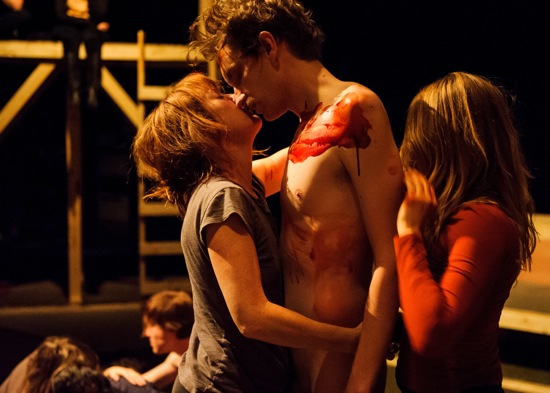
Appetite for death. Bacchantes Jodi Jinx (L) and Hannah Kenah entrap Pentheus (Josh Meyer). Dress rehearsal photo: Ian Douglas
While the Dionysus cast mops up the “blood,” Graves (aka Finley), now in suit and tie, asks all present to consider his candidacy for President of the United States. He urges us to vote in ’68 and showers campaign buttons down from a platform. The curtain that has been hiding NYLA’s usual seating area is drawn aside, and the actors carry him, seated, up the aisle and out the door. He’s urging do-what-you-like freedom, government be damned. Pie in the sky. In 1968, Finley was carried right out into Wooster Street, then the home of small manufacturing lofts.
The performance— engaging, exciting, irritating—stirred a 1960s memory I’d almost forgotten. I was performing at Dance Theater Workshop’s original loft on West 20th Street and exited to the office behind the small audience. That’s where our bags were kept, the dressing rooms being about 6 x 6, if that. A woman who’d left the audience to nurse her baby had her hand in my purse. I asked if she was looking for something. She withdrew her hand, flashed a lovely, sympathetic smile at me, and said, “Don’t get uptight.” I denied any such tendency, of course, but snatched up my purse anyway.
I miss the 1960s and 1970s. The good parts, anyway. Occupy Wall Street roused me. And when I saw Dionysus in 69, the day after the 2012 election, I was primed to enjoy myself.

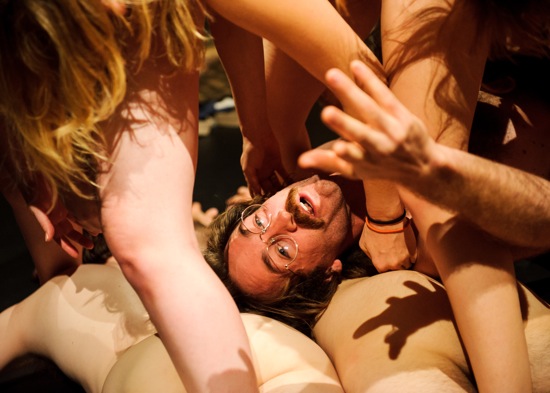
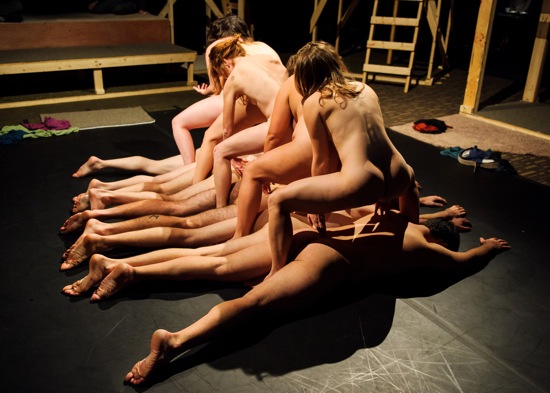
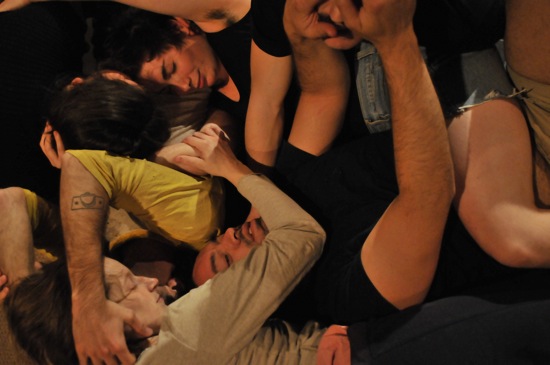
It’s hard to search out knowledgeable people on this matter, however you sound like you recognize what you’re speaking about! Thanks